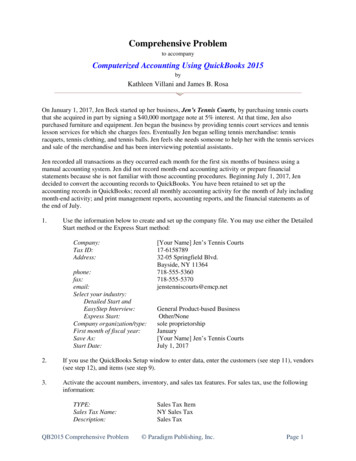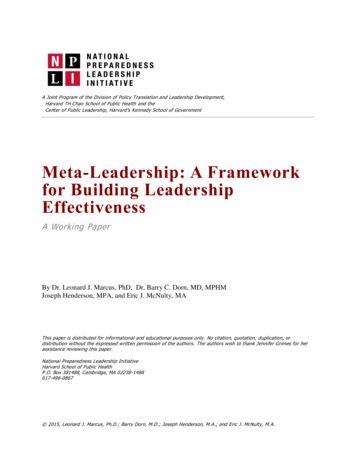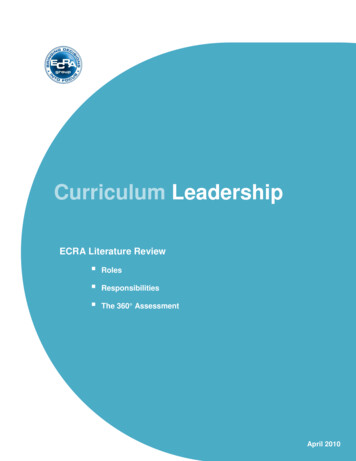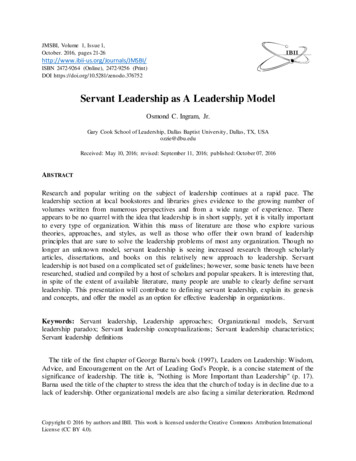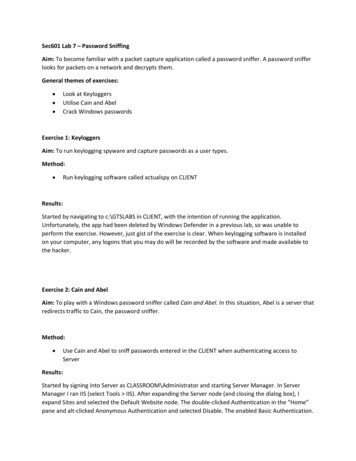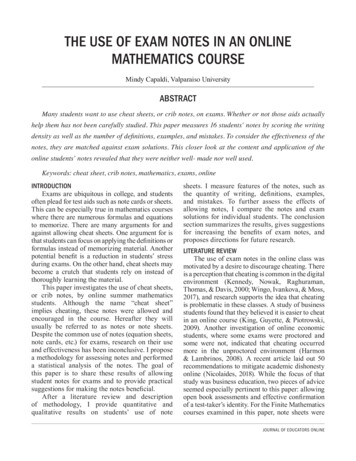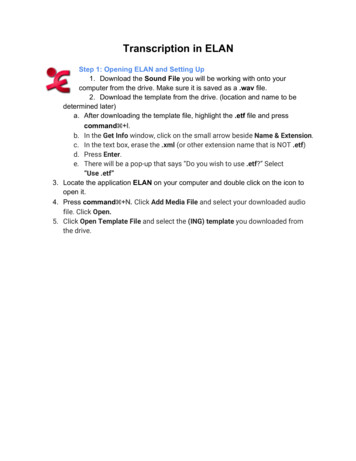
Transcription
LEADERSHIPSixth Edition
To Laurel, Scott, Lisa, and Madison
LEADERSHIPTheory and Practice s 3IXTH %DITIONPETER G. NORTHOUSEWestern Michigan University
FOR INFORMATION:Copyright 2013 by SAGE Publications, Inc.SAGE Publications, Inc.All rights reserved. No part of this book may bereproduced or utilized in any form or by anymeans, electronic or mechanical, includingphotocopying, recording, or by any informationstorage and retrieval system, withoutpermission in writing from the publisher.2455 Teller RoadThousand Oaks, California 91320E-mail: order@sagepub.comSAGE Publications Ltd.1 Oliver’s Yard55 City RoadLondon EC1Y 1SPUnited KingdomPrinted in the United States of AmericaSAGE Publications India Pvt. Ltd.B 1/I 1 Mohan Cooperative Industrial AreaLibrary of Congress Cataloging-in-Publication DataMathura Road, New Delhi 110 044IndiaNorthouse, Peter Guy.SAGE Publications Asia-Pacific Pte. Ltd.33 Pekin Street #02-01Far East SquareLeadership : theory and practice / Peter G.Northouse. -- 6th ed.p. cm.Includes bibliographical references and index.Singapore 048763ISBN 978-1-4522-0340-9 (pbk.)1. Leadership. 2. Leadership--Case studies. I. Title.Acquiring Editor: Lisa Cuevas Shaw andPatricia QuinlinAssociate Editor: Maggie StanleyEditorial Assistant: Mayan N. WhiteHM1261.N67 2013303.3′4--dc232011049043Assistant Editor: MaryAnn VailProject Editor: Eric GarnerCopy Editor: Melinda MassonTypesetter: C&M Digitals (P) Ltd.Proofreader: Susan SchonIndexer:Judy HuntCover Designer: Gail BuschmanMarketing Manager: Helen Salmon/Liz ThortonPermissions Editor: Karen Ehrmann12 13 14 15 16 10 9 8 7 6 5 4 3 2 1
ContentsPrefaceSpecial roductionLeadership DefinedWays of Conceptualizing LeadershipDefinition and ComponentsLeadership DescribedTrait Versus Process LeadershipAssigned Versus Emergent LeadershipLeadership and PowerLeadership and CoercionLeadership and ManagementPlan of the BookSummaryReferences1245678911121414162.Trait rminationIntegritySociabilityFive-Factor Personality Model and LeadershipEmotional IntelligenceHow Does the Trait Approach 62728293032
Case StudiesCase 2.1 Choosing a New Director of ResearchCase 2.2 A Remarkable TurnaroundCase 2.3 Recruiting for the BankLeadership InstrumentLeadership Trait Questionnaire (LTQ)SummaryReferences32333436373840413.Skills ApproachDescriptionThree-Skill ApproachSkills ModelHow Does the Skills Approach Work?StrengthsCriticismsApplicationCase StudiesCase 3.1 A Strained Research TeamCase 3.2 A Shift for Lieutenant Colonel AdamsCase 3.3 Andy’s RecipeLeadership InstrumentSkills 676971724.Style ApproachDescriptionThe Ohio State StudiesThe University of Michigan StudiesBlake and Mouton’s Managerial (Leadership) GridPaternalism/MaternalismOpportunismHow Does the Style Approach Work?StrengthsCriticismsApplicationCase StudiesCase 4.1 A Drill Sergeant at FirstCase 4.2 Eating Lunch Standing UpCase 4.3 We Are FamilyLeadership InstrumentStyle Questionnaire7575767778818283848586878788899293
SummaryReferences95965.Situational ApproachDescriptionLeadership StylesDevelopment LevelsHow Does the Situational Approach Work?StrengthsCriticismsApplicationCase StudiesCase 5.1 What Style Do I Use?Case 5.2 Why Aren’t They Listening?Case 5.3 Getting the Message AcrossLeadership InstrumentSituational 101101111131141161191206.Contingency TheoryDescriptionLeadership StylesSituational VariablesHow Does Contingency Theory Work?StrengthsCriticismsApplicationCase StudiesCase 6.1 No Control Over the Student CouncilCase 6.2 Giving Him a Hard TimeCase 6.3 What’s the Best Leader Match?Leadership InstrumentLeast Preferred Coworker (LPC) 01311311321331341351367.Path–Goal TheoryDescriptionLeader BehaviorsSubordinate CharacteristicsTask CharacteristicsHow Does Path–Goal Theory Work?137137139141142143
StrengthsCriticismsApplicationCase StudiesCase 7.1 Three Shifts, Three SupervisorsCase 7.2 Direction for Some, Support for OthersCase 7.3 Marathon Runners at Different LevelsLeadership InstrumentPath–Goal Leadership 21541551571588.Leader–Member Exchange TheoryDescriptionEarly StudiesLater StudiesLeadership MakingHow Does LMX Theory Work?StrengthsCriticismsApplicationCase StudiesCase 8.1 His Team Gets the Best AssignmentsCase 8.2 Working Hard at Being FairCase 8.3 Taking on Additional ResponsibilitiesLeadership InstrumentLMX 7 91701721731741751771791801821839.Transformational LeadershipDescriptionTransformational Leadership DefinedTransformational Leadership and CharismaA Model of Transformational LeadershipOther Transformational PerspectivesHow Does the Transformational Approach Work?StrengthsCriticismsApplicationCase StudiesCase 9.1 The Vision FailedCase 9.2 An Exploration in Leadership185185186187189196199200202204205206207
Case 9.3 Her Vision of a Model Research CenterLeadership InstrumentSample Items From the Multifactor LeadershipQuestionnaire (MLQ) Form 5X-ShortSummaryReferences20921121321421510.Servant LeadershipDescriptionServant Leadership DefinedHistorical Basis of Servant LeadershipTen Characteristics of a Servant LeaderBuilding a Theory About Servant LeadershipModel of Servant LeadershipAntecedent ConditionsServant Leader BehaviorsOutcomesSummary of the Model of Servant LeadershipHow Does Servant Leadership Work?StrengthsCriticismsApplicationCase StudiesCase 10.1 Anonymous Servant LeadersCase 10.2 Doctor to the PoorCase 10.3 Servant Leadership Takes FlightLeadership InstrumentServant Leadership 1.Authentic LeadershipDescriptionAuthentic Leadership DefinedApproaches to Authentic LeadershipHow Does Authentic Leadership Theory Work?StrengthsCriticismsApplicationCase StudiesCase 11.1 Am I Really a Leader?Case 11.2 A Leader Under FireCase 11.3 The Reluctant First Lady253253254255266267269270270271274276
12.13.Leadership InstrumentAuthentic Leadership Self-Assessment QuestionnaireSummaryReferences278280282283Team LeadershipSusan E. Kogler HillDescriptionTeam Leadership ModelHow Does the Team Leadership Model Work?StrengthsCriticismsApplicationCase StudiesCase 12.1 Can This Virtual Team Work?Case 12.2 They Dominated the ConversationCase 12.3 Starts With a Bang, Ends With a WhimperLeadership InstrumentTeam Excellence and Collaborative Team ic ApproachErnest L. StechDescriptionEric Berne and Transactional AnalysisSigmund Freud and Personality TypesSocial Character and a Shift inLeadership PerspectiveCarl Jung and Personality TypesTypes and LeadershipHow Does the Psychodynamic Approach Work?StrengthsCriticismsCase StudiesCase 13.1 Not the Type Who Seesthe Big PictureCase 13.2 Staff Meeting ProblemsCase 13.3 Unexpected ReactionsLeadership InstrumentPsychodynamic Approach 5319322325328330333338338339340341342343344345
SummaryReferences14.15.347348Women and LeadershipCrystal L. HoytDescriptionGender, Leadership Styles, andLeadership EffectivenessThe Glass Ceiling Turned LabyrinthStrengthsCriticismsApplicationCase StudiesCase 14.1 The “Glass Ceiling”Case 14.2 Lack of Inclusion and CredibilityCase 14.3 Pregnancy as a Barrier to Job StatusLeadership InstrumentThe Gender–Leader Implicit Association TestSummaryNoteReferences349Culture and LeadershipDescriptionCulture DefinedRelated ConceptsDimensions of CultureClusters of World CulturesCharacteristics of ClustersLeadership Behavior and Culture ClustersUniversally Desirable and UndesirableLeadership AttributesStrengthsCriticismsApplicationCase StudiesCase 15.1 A Challenging WorkplaceCase 15.2 A Special Kind of FinancingCase 15.3 Whose Hispanic Center Is It?Leadership InstrumentDimensions of Culture 410411414415
SummaryNotesReferences16.Leadership EthicsDescriptionEthics DefinedEthical TheoriesCentrality of Ethics to LeadershipHeifetz’s Perspective on Ethical LeadershipBurns’s Perspective on Ethical LeadershipPrinciples of Ethical LeadershipStrengthsCriticismsApplicationCase StudiesCase 16.1 A Struggling Company WithoutEnough CashCase 16.2 How Safe Is Safe?Case 16.3 Reexamining a ProposalLeadership InstrumentPerceived Leader Integrity Scale 429430437438439439440441443444446448449Author Index453Subject Index463About the Author483About the Contributors485
PrefaceThis sixth edition of Leadership: Theory and Practice is written withthe objective of bridging the gap between the often-simplistic popular approaches to leadership and the more abstract theoretical approaches.Like the previous editions, this edition reviews and analyzes a selectednumber of leadership theories, giving special attention to how each theoretical approach can be applied in real-world organizations. In essence, mypurpose is to explore how leadership theory can inform and direct the wayleadership is practiced.New to this volume is a chapter on servant leadership, which examinesthe nature of servant leadership, its underpinnings, and how it works. Thechapter presents both a definition and a new evidence-based model ofservant leadership. In addition, the strengths and weaknesses of the servantleadership approach are examined, and a questionnaire to help readersassess their own levels of servant leadership is provided. Three case studiesillustrating servant leadership are presented at the end of the chapter.This edition retains many special features from previous editions but hasbeen updated to include new research findings, figures and tables, andeveryday applications for many leadership topics including leader–memberexchange theory, transformational and authentic leadership, team leadership, the labyrinth of women’s leadership, and historical definitions ofleadership. The format of this edition parallels the format used in earliereditions. As with previous editions, the overall goal of Leadership: Theoryand Practice is to advance our understanding of the many differentapproaches to leadership and ways to practice it more effectively.xiii
xiv LEADERSHIPTHEORY AND PRACTICESPECIAL FEATURESAlthough this text presents and analyzes a wide range of leadershipresearch, every attempt has been made to present the material in a clear,concise, and interesting manner. Reviewers of the book have consistentlycommented that clarity is one of its major strengths. In addition to thewriting style, several other features of the book help make it user-friendly. Each chapter follows the same format: It is structured to include firsttheory and then practice. Every chapter contains a discussion of the strengths and criticisms ofthe approach under consideration, and assists the reader in determining the relative merits of each approach. Each chapter includes an application section that discusses the practical aspects of the approach and how it could be used in today’sorganizational settings. Three case studies are provided in each chapter to illustrate common leadership issues and dilemmas. Thought-provoking questionsfollow each case study, helping readers to interpret the case. A questionnaire is provided in each of the chapters to help the readerapply the approach to his or her own leadership style or setting. Figures and tables illustrate the content of the theory and make theideas more meaningful.Through these special features, every effort has been made to make thistext substantive, understandable, and practical.AUDIENCEThis book provides both an in-depth presentation of leadership theory anda discussion of how it applies to real-life situations. Thus, it is intended forundergraduate and graduate classes in management, leadership studies,business, educational leadership, public administration, nursing and alliedhealth, social work, criminal justice, industrial and organizational psychology, communication, religion, agricultural education, political and military science, and training and development. It is particularly well suited asa supplementary text for core organizational behavior courses or as anoverview text within MBA curricula. This book would also be useful as atext in student activities, continuing education, in-service training, andother leadership-development programs.
Preface xvInstructor Teaching SiteInstructor Resources are available on the password-protected section of thebook’s companion website. Test banks include multiple choice and true/false questions to test comprehension of fundamental material, as well as essay questions thatask students to apply the material. An electronic testbank, compatible with PCsand Macs through Diploma software, is also available. Chapter-specific resourcesinclude PowerPoint slides, study and discussion questions, suggested exercises, fulltext journal articles, video links, audio links, and full-text reference articles. Generalresources include course-long projects, sample syllabi, and film resources.Printable PDF versions of the questionnaires from the text are included for instructors to print and distribute for classroom use. The companion site also featuresinformation on how to use social media with Leadership, 6th edition, includinginstructions for creating wikis, blogs, and Twitter feeds to accompany the text andspecific topics to discuss using these different technologies. Go to www.sagepub.com/northouse6e to access the companion site.Student Study SiteTo maximize students’ comprehension of this material, student resourcesare available on the open-access portion of the book’s companion website.Resourc
Servant Leadership Questionnaire 245 Summary 248 References 249 11. Authentic Leadership 253 Description 253 Authentic Leadership Defined 254 Approaches to Authentic Leadership 255 How Does Authentic Leadership Theory Work? 266 Strengths 267 Criticisms 269 Application 270 Case Studies 270 Case 11.1 Am I Really a Leader? 271 Case 11.2 A Leader Under Fire 274 Case 11.3 The Reluctant
